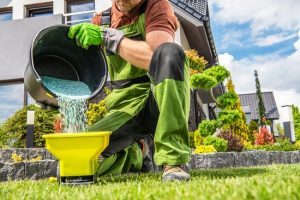 The majority of people fertilize their lawns with a single application in spring followed by a few more during the growing season. Lawn care experts do not fertilize your lawn too early in the growing season. Late spring is the best time to fertilize your lawn. This is when the green grass is just beginning to grow. The grass puts energy into root development in early spring. Apply fertilizer too early and the plant will turn its energy to leaf development.
The majority of people fertilize their lawns with a single application in spring followed by a few more during the growing season. Lawn care experts do not fertilize your lawn too early in the growing season. Late spring is the best time to fertilize your lawn. This is when the green grass is just beginning to grow. The grass puts energy into root development in early spring. Apply fertilizer too early and the plant will turn its energy to leaf development.
The Controversy About Using Lawn Fertilizers
The decision about whether fertilizer should be used on your lawn will depend on your stand when it comes to organic or low-impact-to-chemical garden practices. Organic gardeners do not use any chemicals as lawn fertilizers. It is important to note that fertilizer runoff can get into the local water supply. It is clear that fertilizer run-off from lawns and agricultural fertilizers can contaminate groundwater supplies and streams, creating an urgent environmental problem.
Lawn Care: Organic Fertilizer
There are several organic ways to safely feed a lawn. A mulching mower cuts grass into small pieces that are then broken down on the lawn. Experts in lawn care in Myrtle Beach say this method provides the lawn with twice as much nitrogen than a single application of fertilizer. Although organic-labeled fertilizers can feed your lawn, they tend to be less saturated with essential nutrients (nitrogen and phosphorus) than industrially processed fertilizers.
Lawn Care: Non-organic Fertilizer
The most popular type of lawn fertilizer is still traditional chemical lawn fertilizer. It can be supplied by your local lawn care provider, Conner’s Lawn Care. There are many types of fertilizers. There are fertilizers that match the season. These include early-season fertilizers and mid-summer fertilizers. Some fertilizers are better suited to vegetables or flowers. The herbicides category also includes fertilizers that feed the grass and kill weeds.
Pre-emergent herbicides combine fertilizer with crabgrass control herbicide and are applied in the spring. This product does not require a full feed of fertilizer. The product contains a small amount of fertilizer that boosts grass growth, keeps it alive, and a herbicide that restricts the development of crabgrass seedlings.
Fertilizer should be used with care
Most fertilizer manufacturers are too strict about the recommended dosage and feeding schedule. The more fertilizer you use the better. Begin with half of the recommended fertilizer rate and dosage. If you aren’t satisfied with the results, you can apply again. You’ll see how long it takes to have a healthy lawn after a few seasons.
Fertilizer Application Timing
Organic fertilizers are preferred by some homeowners who may apply one “turf-builder application” in the fall to establish root systems. Most lawns will not require fertilizers in the spring or summer and can rely solely on nitrogen from the mulched grass clippings.
Traditional fertilizers can be applied to the lawn in three applications. One in spring, one in midsummer for those areas, and one in fall.
Once you have determined the best time to apply fertilizer, plan your application. You will need to water your lawn at least quarter inch before you apply fertilizer. Apply fertilizer only after a severe storm. Rainstorms increase the likelihood of fertilizer nutrients being pushed into storm drains or streams.
When To Fertilize Your Lawn During Spring
The slow-release fertilizer function will aid grass growth if you applied lawn fertilizer in the fall, particularly late in the season. Although fertilizer companies and lawn care companies might tell you to fertilize your lawn early in the spring, turf experts and agronomists (soil specialists) may advise you to wait.
Cool-season grasses that “wake up” in spring enter a natural growth phase when their root system starts growing and creating energy (carbohydrate) reserves. Before fertilizing the lawn, wait until late spring (late May/early June), just before the heat of the summer starts and the grass thrives.
This is the best time to start feeding your lawn for the summer. The grass will slow down its carbohydrate production during the summer and start to use the reserves. The grass will benefit from adequate feedings. This will help it rebuild its energy (carbohydrates) and protect it against the summer stresses, such as heat, drought, traffic, illness, and insect infestations. The grass can be fed for as long as 12 weeks with a slow-release fertilizer that is polymer-coated.
Conner’s Lawn Care specializes in fertilization and weed control. Spring is a busy time for landscapers. Call us today to put your lawn on our schedule
Conner’s Lawn Care Service
Myrtle Beach, SC
843-504-4901
http://connerslawncare.com/